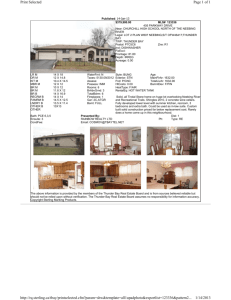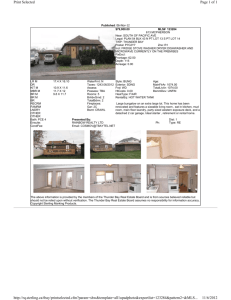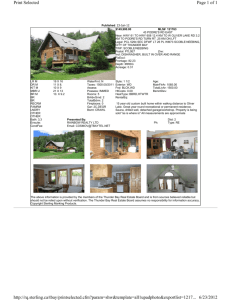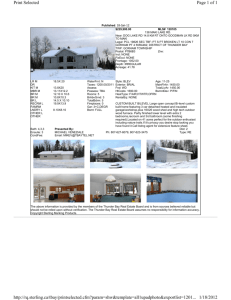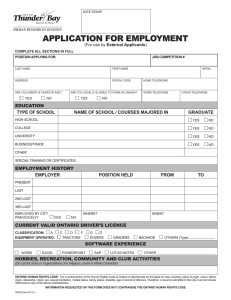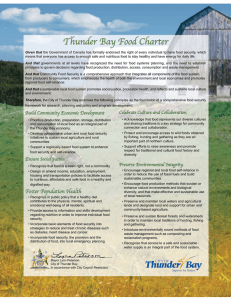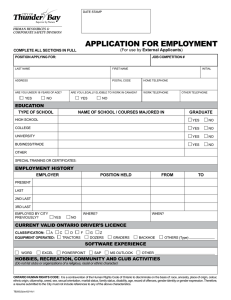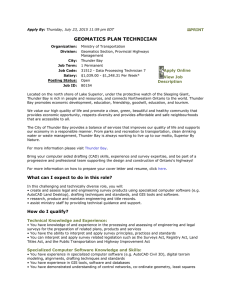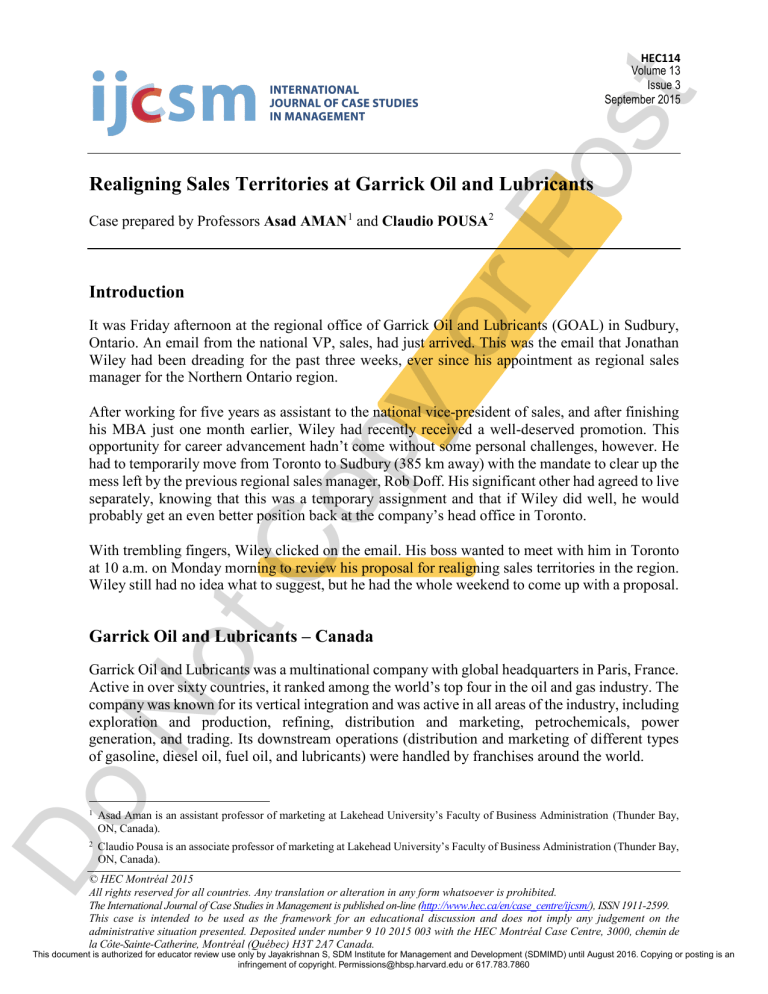
rP os t HEC114 Volume 13 Issue 3 September 2015 Realigning Sales Territories at Garrick Oil and Lubricants Case prepared by Professors Asad AMAN 1 and Claudio POUSA 2 op yo Introduction It was Friday afternoon at the regional office of Garrick Oil and Lubricants (GOAL) in Sudbury, Ontario. An email from the national VP, sales, had just arrived. This was the email that Jonathan Wiley had been dreading for the past three weeks, ever since his appointment as regional sales manager for the Northern Ontario region. tC After working for five years as assistant to the national vice-president of sales, and after finishing his MBA just one month earlier, Wiley had recently received a well-deserved promotion. This opportunity for career advancement hadn’t come without some personal challenges, however. He had to temporarily move from Toronto to Sudbury (385 km away) with the mandate to clear up the mess left by the previous regional sales manager, Rob Doff. His significant other had agreed to live separately, knowing that this was a temporary assignment and that if Wiley did well, he would probably get an even better position back at the company’s head office in Toronto. With trembling fingers, Wiley clicked on the email. His boss wanted to meet with him in Toronto at 10 a.m. on Monday morning to review his proposal for realigning sales territories in the region. Wiley still had no idea what to suggest, but he had the whole weekend to come up with a proposal. No Garrick Oil and Lubricants – Canada Do Garrick Oil and Lubricants was a multinational company with global headquarters in Paris, France. Active in over sixty countries, it ranked among the world’s top four in the oil and gas industry. The company was known for its vertical integration and was active in all areas of the industry, including exploration and production, refining, distribution and marketing, petrochemicals, power generation, and trading. Its downstream operations (distribution and marketing of different types of gasoline, diesel oil, fuel oil, and lubricants) were handled by franchises around the world. 1 Asad Aman is an assistant professor of marketing at Lakehead University’s Faculty of Business Administration (Thunder Bay, ON, Canada). 2 Claudio Pousa is an associate professor of marketing at Lakehead University’s Faculty of Business Administration (Thunder Bay, ON, Canada). © HEC Montréal 2015 All rights reserved for all countries. Any translation or alteration in any form whatsoever is prohibited. The International Journal of Case Studies in Management is published on-line (http://www.hec.ca/en/case_centre/ijcsm/), ISSN 1911-2599. This case is intended to be used as the framework for an educational discussion and does not imply any judgement on the administrative situation presented. Deposited under number 9 10 2015 003 with the HEC Montréal Case Centre, 3000, chemin de la Côte-Sainte-Catherine, Montréal (Québec) H3T 2A7 Canada. This document is authorized for educator review use only by Jayakrishnan S, SDM Institute for Management and Development (SDMIMD) until August 2016. Copying or posting is an infringement of copyright. Permissions@hbsp.harvard.edu or 617.783.7860 rP os t Realigning Sales Territories at Garrick Oil and Lubricants In 2014, in the business-to-consumer end of its business, the company managed some 770 franchised gas stations in Canada. In addition, it operated 46 company-owned gas stations in large metropolitan areas such as Toronto and Vancouver. The company-owned gas stations were touted as being the “ideal” or “benchmark” operations that franchisees were expected to emulate, thus consolidating GOAL’s control over the franchisees in the distribution channel. All of the company-owned and 80% of the franchised gas stations incorporated a small convenience store. In the case of franchised gas stations, these stores were usually run by the franchise owners and their family members. Convenience stores in the company-owned gas stations were subcontracted to local entrepreneurs who reported to GOAL’s sales staff to ensure service standards were maintained. The sourcing of convenience products was managed locally by franchise owners and entrepreneurs through area wholesalers. op yo In Canada, GOAL’s consumer sales department was divided into eleven regions, with each region subdivided into a number of sales territories based on the number of franchisees (Table 1). The national vice-president, sales, oversaw GOAL’s relationship with franchisees through the intermediary of eleven regional sales teams. Each regional sales team consisted of a regional sales manager (RSM) and a number of territory sales managers (TSM), usually between four and ten, depending on the size of the region. While accountable for maintaining service standards in the convenience stores, GOAL’s regional sales teams focused primarily on the sale of GOAL’s core products: gasoline and lubricants. Do No tC Gasoline was distributed to all franchisees and company-owned outlets throughout Canada via a company-owned fleet of tanker trucks. Lubricants were distributed via a more complex supply chain, as they had to be delivered to three major outlet types: gas stations (both franchised and company-owned), national retail chains such as Walmart and Canadian Tire, and local independent auto workshops and wholesalers. In major cities such as Toronto, Montreal, and Vancouver, lubricants were distributed to gas stations and small auto workshops by a company-owned fleet of vehicles. In smaller towns and regions, the company used independent distributors to distribute lubricants to gas stations, independent auto workshops, and local wholesalers. Lubricant sales to national retail chains such as Walmart and Canadian Tire were managed centrally by a Key account team in the Toronto head office. © HEC Montréal 2 This document is authorized for educator review use only by Jayakrishnan S, SDM Institute for Management and Development (SDMIMD) until August 2016. Copying or posting is an infringement of copyright. Permissions@hbsp.harvard.edu or 617.783.7860 rP os t Realigning Sales Territories at Garrick Oil and Lubricants Table 1. GOAL’s sales in Canada in 2014 (gas and lubricants) No. of franchisees Company-owned % $ share Maritime provinces 52 2 6 Quebec North 43 1 4 Quebec South 102 5 18 Ontario North 43 2 3 Ontario South 128 10 18 Manitoba 40 1 6 Saskatchewan 29 1 4 Alberta North Alberta South British Columbia North British Columbia South Total op yo Region 78 7 9 93 8 13 54 2 5 109 7 14 770 46 100% Note: The company did not cover the Yukon, Northwest Territories or Nunavut in 2014. It was at a developmental stage in Saskatchewan and Manitoba. tC The Northern Ontario sales region No Northern Ontario was a vast region with a small number of franchisees scattered throughout the territory. It covered a little over 800,000 square kilometers with almost 740,000 inhabitants, or an average of just under one inhabitant per square kilometer. The biggest cities were Sudbury (some 160,000 inhabitants), Thunder Bay (110,000), Sault Ste. Marie (75,000) and North Bay (55,000). The region’s primary economic sectors were mining, forestry, manufacturing, transportation, government, and tourism. In Northern Ontario, GOAL had 43 independent franchisees and two company-owned retail gas stations. The region accounted for just 3% of GOAL’s total sales in Canada in 2014 (Table 1). In 2009, sales in the Northern Ontario region began to decline. Franchisees began complaining about the lack of service, and their relationship with GOAL deteriorated (the company measured its relationship with franchisees using a system of franchise data collection and analysis implemented by an independent third party). Do In 2010, to address these issues, Rob Doff, the regional sales manager at the time, decided to rearrange sales territories in Northern Ontario (see Figure 1 and Tables 2 and 3) and to adjust the organizational structure by re-assigning salespeople to different accounts (franchise operations). He believed the declining sales performance was due to sales force complacency. He knew that the same salespeople had been serving the same accounts for many years and believed this had led them to take sales for granted, disregard new business opportunities, and become lazy. He hoped © HEC Montréal 3 This document is authorized for educator review use only by Jayakrishnan S, SDM Institute for Management and Development (SDMIMD) until August 2016. Copying or posting is an infringement of copyright. Permissions@hbsp.harvard.edu or 617.783.7860 rP os t Realigning Sales Territories at Garrick Oil and Lubricants that re-assigning the territories would challenge salespeople to learn about new accounts and territories and spot new sales opportunities, stimulating them to greater effort and commitment. His plan backfired. The sales force reacted badly to the changes and took every opportunity to complain about the situation to people both inside and outside the company. Sales continued to fall. The regional sales force was rumoured to be having internal problems. The internal pressure on Doff increased and, after two of the four salespersons quit in 2012, he was asked to leave. Current Situation op yo Due to the shortage of mid-level sales management talent, Wiley was given a chance to prove himself in the field. After Doff left, the company could not immediately appoint a new regional manager. As assistant to the VP sales in the Toronto head office, Wiley was responsible for collecting and analyzing sales data from the regions and coordinating a variety of administrative tasks with salespeople in the field. He also occasionally contacted franchisees directly to collect data. Although he had no formal authority to supervise territory sales managers (TSMs), he had done a good job managing the situation in Northern Ontario remotely and, at the same time, had learned a lot about the different salespeople and the characteristics of the region. tC The most senior salesperson in the region was Tom, a veteran in his early fifties with twenty years’ industry experience (eighteen years at GOAL) but no university or college education. Tom lived in Thunder Bay and managed the Thunder Bay territory. Despite his lack of formal education, Tom was experienced and familiar with a number of sales techniques. Wiley had met Tom at several national sales meetings. At those meetings, Tom had usually come across as being highly critical of the company and its management. He was also cynical about changes to the management structure and new product development. In the past, Tom had been a good performer (two stars, in GOAL’s jargon) 1 but in the last couple of years his performance had dropped to one star. No Melissa was the other senior salesperson in the region. In her mid-fifties, she had a college diploma in business administration. Like Tom, she was highly experienced, with sixteen years in the industry, the last eight of them with GOAL. Melissa had a reputation for being friendly and knowledgeable about sales in general and the Northern Ontario region in particular. Although her early performance had not been good (one star), in the last couple of years her sales had improved and she had become a good performer, earning a “two star” rating. Melissa lived in Sault Ste. Marie and managed the Sault Ste. Marie, Timmins, and Wawa markets. Do In his mid-thirties, Jim was a new hire in the Northern Ontario region, taken on when the two salespeople quit in 2012. After earning a college-level sales certificate, he was awarded the Certified Sales Professional (CSP) designation from the Canadian Professional Sales Association. He had seven years’ experience in the industry, the last two at GOAL. Jim had a reputation for being an “achiever.” He always had something positive to say about his job, the company, and his 1 For years, GOAL has used a star system to measure sales performance. Three stars means that a salesperson consistently achieves more than 100% of their quota. Two stars means they achieve between 95% and 100% of their quota. One star means they achieve between 85% and 95% of their quota. Salespeople who don’t achieve at least 85% of their quota are regarded as poor performers and usually lose the position of territory sales manager. © HEC Montréal 4 This document is authorized for educator review use only by Jayakrishnan S, SDM Institute for Management and Development (SDMIMD) until August 2016. Copying or posting is an infringement of copyright. Permissions@hbsp.harvard.edu or 617.783.7860 rP os t Realigning Sales Territories at Garrick Oil and Lubricants results. His performance at GOAL had been excellent (three stars) from the beginning. Originally from Toronto, Jim had moved to Sudbury when he joined GOAL. He managed the Sudbury and North Bay markets and was interested in taking on more challenging roles within the region. Finally, Ben was the rookie in the region. He was in his mid-twenties and had recently earned a Bachelor of Commerce degree from a Canadian university. After a number of previous positions, he had been working for GOAL for one year. For the last year he had been a good performer (two stars), and he appeared to be committed to providing excellent service and developing good customer relationships. Ben managed the Dryden, Sioux Lookout, Fort Francis, and Neebing markets. Occasionally, he also helped Tom in the Thunder Bay area. op yo The TSM Role in Northern Ontario The TSM role in Northern Ontario was challenging. TSMs were required to travel extensively, sometimes spending nights on the road. Some gas stations were located between towns, and they had to drive several hundred kilometers to call on those accounts. tC During their visits to franchisees, TSMs were expected to work on four key areas: monthly sales planning, relationship building, business development, and training and communication. During their monthly sales planning meetings with franchise owners, they discussed monthly and annual sales targets and quotas. Any deviations from sales targets (past and forecast) would be discussed. This “harder” aspect of the job was coupled with the “softer” aspect of relationship building. TSMs used different strategies in this area. A basic strategy was to entertain franchise owners and their staff by taking them out to lunch or dinner, to an occasional round of golf in summer, or to hockey games between regional teams at the local arena. No In their business development role, the TSMs would help franchisees evaluate and develop their businesses. Four times a year, the TSMs and the franchise owners were expected to have an indepth discussion about their respective businesses. The TSMs’ role was to ensure that franchise operations achieved their optimum return on investment (ROI), and this discussion would provide owners with valuable feedback to help maximize profits. The TSMs also helped generate new business for franchise operations by helping them negotiate and sign agreements with local businesses, for example. Given the geographical spread of the region, even smaller companies travelled long distances every month and consumed large amounts of gas. Such business customers provided a stable stream of revenue for local franchise operations. TSMs would also help franchisees search for new leads, call on potential accounts, and prepare and submit bids. Do Finally, in the training and communication area, the TSMs would hold on-the-job training sessions on sales and merchandising techniques for the franchisee’s staff and inform them about any upcoming promotions. This also gave the TSMs an opportunity to monitor the service standards of the franchisee operations. In the communication area, the TSMs would also address any problems the franchisees might be having with the delivery of products by GOAL’s fleet of tanker trucks. All the TSMs in the Northern Ontario region were responsible for these activities in their respective territories, but the Thunder Bay TSM had additional responsibilities. These responsibilities were © HEC Montréal 5 This document is authorized for educator review use only by Jayakrishnan S, SDM Institute for Management and Development (SDMIMD) until August 2016. Copying or posting is an infringement of copyright. Permissions@hbsp.harvard.edu or 617.783.7860 rP os t Realigning Sales Territories at Garrick Oil and Lubricants related to the additional channels this TSM had to manage, specifically the company-owned gas stations and the regional lubricants distributor. Each of the two company-owned gas stations in Thunder Bay was staffed by a retail manager and four team members, all GOAL employees reporting to the Thunder Bay TSM. Lubricants were distributed by Empire Oil, a distribution company with a regional office in Thunder Bay. With two warehouses, one in Thunder Bay and the other in Sudbury, Empire Oil delivered GOAL lubricants to all gas stations in the region and to independent automobile repair shops. In addition to managing relationships with the franchisees and the company-owned gas stations, the Thunder Bay TSM had to manage GOAL’s relationship with Empire Oil. Other TSMs in the region helped the Thunder Bay TSM in this task by visiting Empire Oil’s Sudbury warehouse and by visiting some of their customers (i.e., local automobile workshops and small wholesalers). The Decision op yo Due to these additional responsibilities, the Thunder Bay TSM reported not only to the regional sales manager but also to the national distribution and wholesale manager – lubricants. Distribution to national chains such as Walmart and Canadian Tire was managed centrally at head office by a national key accounts team and thus did not come under the purview of the Thunder Bay TSM. However, the TSM still had to keep an eye on pricing and promotions at local outlets of those national chains so that any pricing differences in the two channels (i.e., national chains and Empire Oil) could be minimized. tC After opening his boss’s email, Wiley knew he had to stop procrastinating. The main purpose of his appointment to the position of regional sales manager was to put the house in order. He had to decide how to divide the region into territories and which accounts and salespeople to assign to each one (see Tables 2 and 3, and Figure 1). No For the previous few weeks since his appointment, Wiley had been thinking about the problem, and he knew it was complex and multi-dimensional. A single decision criterion could not be used. On the contrary, various criteria could optimize the result in one way, but sub-optimize it in others. The consequences of using the wrong criteria and making the wrong decision were daunting. He could follow Doff’s downward spiral and be “asked to leave” in a few months. If that happened, all his hopes for building a successful career after earning his MBA would go down the drain. Do Wiley knew he had a tough weekend ahead. © HEC Montréal 6 This document is authorized for educator review use only by Jayakrishnan S, SDM Institute for Management and Development (SDMIMD) until August 2016. Copying or posting is an infringement of copyright. Permissions@hbsp.harvard.edu or 617.783.7860 rP os t Realigning Sales Territories at Garrick Oil and Lubricants Table 2. Northern Ontario Region City/Town/Highway No. of Franchisees Average franchisee relationship (*=Poor, **=Fair, ***=Good) (2013 assessment) No. of GOALowned stations Percentage of Northern Ontario sales (2013) Dryden 2 ** Fort Francis 1 * Neebing 1 * North Bay 5 * Sault Ste. Marie 6 * Sioux Lookout 1 ** Sudbury 6 *** 5 ** 2 *** 3% 1 ** 2% 3 * 5% 2 ** 5% 4 *** 8% HWY 17 Sault Ste. Marie-Thunder Bay 3 ** 5% HWY 17 Thunder Bay-Dryden 1 * 1% ** 17% Timmins Wawa HWY 11 Timmins-Thunder Bay HWY 11 Timmins-North Bay HWY 17 Sault Ste. Marie-North Bay Thunder Bay Lubricants Distributor 2% 11% 10% 2% 14% 2 11% 43 tC TOTAL 1% op yo Thunder Bay 3% 100% Table 3. Distance between Cities in the Northern Ontario Region Dryden Neebing North Bay 118 0 351 1368 357 351 0 1164 1465 1368 1164 0 932 733 436 285 383 1490 1240 347 1136 806 1035 35 841 511 128 1137 362 658 Sault Ste. Marie 1034 932 733 436 0 Sioux Lookout Sudbury Thunder Bay Timmins Wawa 99 285 383 1490 1060 1335 1240 1035 128 307 353 347 35 1137 706 1142 1136 841 362 439 812 806 511 658 228 1060 0 1362 379 1167 838 307 706 439 228 1362 379 1167 838 0 1008 293 529 1008 0 814 484 293 814 0 330 529 484 330 0 Do No Dryden 0 Fort Francis 118 Neebing 357 North Bay 1465 Sault Ste. 1034 Marie Sioux 99 Lookout Sudbury 1335 Thunder Bay 353 Timmins 1142 Wawa 812 Distances are in kilometers Source: Google maps Fort Francis © HEC Montréal 7 This document is authorized for educator review use only by Jayakrishnan S, SDM Institute for Management and Development (SDMIMD) until August 2016. Copying or posting is an infringement of copyright. Permissions@hbsp.harvard.edu or 617.783.7860 Realigning Sales Territories at Garrick Oil and Lubricants op yo rP os t Figure 1. Northern Ontario Regional Map 1 Jim Jim Do No tC Jim Jim 2015-07-29 1 The map indicates city locations only. Distances are not accurate. © HEC Montréal 8 This document is authorized for educator review use only by Jayakrishnan S, SDM Institute for Management and Development (SDMIMD) until August 2016. Copying or posting is an infringement of copyright. Permissions@hbsp.harvard.edu or 617.783.7860
